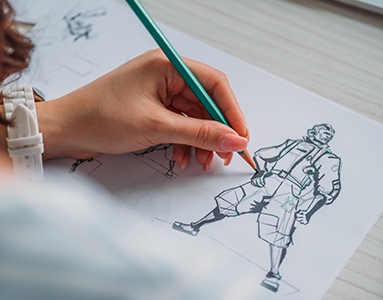Game Art, B.S.
About This Program
Students of both the Game Art track — and the Contemporary Arts Practice track — can expect:
Personalized Learning Experience:
Our intimate program ensures that you’re known by name, receiving tailored instruction
that nurtures your unique artistic vision and personal growth.
Hands-On Opportunities:
Engage in dynamic, real-world projects throughout your journey at FAMU, including
the chance to curate your own exhibitions at the Foster-Tanner Fine Arts Gallery.
These opportunities allow you to experiment, refine your skills, and prepare for a
career in the contemporary and digital art world.
Successful Alumni Network:
Our graduates have made significant strides in the art world and beyond, gaining acceptance
into top graduate programs and thriving in creative industries. Join a community of
successful alumni who are shaping the future of contemporary and digital art.
Both Contemporary Arts Practice and Game Art emphasize creativity, innovation, and a deep understanding of cultural contexts, preparing individuals to contribute significantly to contemporary artistic and digital landscapes.

What is Game Art?
Key components of the program include:
• 3D Modeling and Animation: Learning software tools to create lifelike characters and immersive environments.
• Concept Art: Developing visual ideas and sketches that guide game aesthetics.
• Game Design Principles: Understanding gameplay mechanics, narrative structure, and player interaction.
Types of Graduates - Graduates typically find roles as:
• Game artists or animators
• Concept artists
• Environmental artists
• UI/UX designers for games
• Art directors in game development studios

Game Art Careers
Upon completing a Game Art major, individuals typically pursue a range of career paths within the video game industry and related fields. Common roles include game artist, where they create character models and environments; concept artist, responsible for visualizing ideas and designs; and animator, focusing on bringing characters and scenes to life.
Many graduates also find opportunities as UI/UX designers, ensuring intuitive player interactions, or as environment artists, crafting immersive game worlds. Additionally, some may take on roles in art direction or game design, contributing to the overall visual and gameplay experience. The dynamic nature of this industry allows for diverse and evolving career trajectories.
• Game Designer: Conceptualizes game mechanics, storylines, and gameplay experiences.
• Level Designer: Creates the environments and levels players navigate through.
• Game Programmer: Writes the code that makes the game function, focusing on gameplay mechanics, graphics, and AI.
• 2D Artist: Creates 2D artwork, including character designs, backgrounds, and UI elements.
• 3D Artist: Designs and models 3D assets, characters, and environments.
• Animator: Brings characters and environments to life through movement and animation.
• Sound Designer: Develops the audio elements of the game, including sound effects and music.
• Game Producer: Manages the game development process, coordinating teams and resources.
• Quality Assurance (QA) Tester: Tests games for bugs, balancing issues, and overall quality.
• Narrative Designer: Develops the story, dialogue, and character arcs within the game.
• Marketing Manager: Promotes the game and manages its public relations and marketing strategies.
• Community Manager: Engages with the gaming community, managing feedback and fostering relationships.
• Technical Artist: Acts as a bridge between artists and programmers, ensuring visual quality and performance.
• User Experience (UX) Designer: Focuses on creating intuitive and enjoyable player experiences.
• Game Analyst: Analyzes player data to inform game design and marketing strategies.

Game Art Employment Expectations
The States with the highest employment rate for Game Art are:
1.California
- Home to major game studios like Electronic Arts, Activision Blizzard, and many indie
developers.
- Cities like Los Angeles and San Francisco are hubs for the industry.
2. Washington
- Seattle is a key city with companies like Microsoft and Valve.
- Strong presence of both AAA and indie studios.
3. Texas
- Austin and Dallas are growing hubs for game development.
- Notable companies include Gearbox Software and id Software.
4. New York
- New York City has a vibrant game scene with a mix of indie developers and larger
studios.
- Strong focus on mobile and casual games.
5. Florida
- Cities like Orlando and Miami are emerging as game development centers.
- Diverse opportunities in both AAA and indie game development.
6. North Carolina
- The Research Triangle area is seeing growth in tech and game development.
- Home to several indie studios and educational institutions focused on gaming.
7. Massachusetts
- Boston has a strong gaming community, particularly in educational and mobile games.
- Home to several prominent universities with game design programs.
8. Illinois
- Chicago has a growing number of game developers and startups.
- Hosts events like the Chicago Indie Game Jam.

Game Art Frequently Asked Questions (F.A.Qs)
Q: What makes Game Art unique?
A: Game Art continuously evolves with advancements in technology, offering opportunities
to explore virtual reality (VR), augmented reality (AR), and cutting-edge graphics.
The skills gained are versatile, allowing professionals to work in various industries,
including gaming, film, advertising, and education.
Q: What are some non-traditional career paths for Game Art graduates?
A: Students learn industry-standard software for 3D modeling, animation, and concept
art, including tools commonly used in game development. This provides a solid foundation
in both the technical and artistic aspects of game creation.
Q: What kind of skills will I gain from this program?
A: In addition to game development roles, graduates can work in animation studios, virtual
reality (VR) design, digital marketing, film production, and even educational game
design, offering diverse career trajectories.
Game Art Curriculum Map
Total Hours 120 (minimum)
1st SEMESTER — 14 Credit Hours |
|
|---|---|
| Name Course Number & Name | Credit Hours |
|
SLS 1101: Student Life Skills |
2 |
| ENC 1101: Freshman Communication Skills I (Gen Ed) | 3 |
| MGF 1130: Mathematical Thinking | 3 |
| ART 2300C: Drawing I | 3 |
| ART 1201C: Fundamentals of Design I | 3 |
| Total Semester Credit Hours - 14 | |
2Nd SEMESTER — 15 Credit Hours |
|
|---|---|
| Name Course Number & Name | Credit Hours |
| ENC 1102: Freshman Communication Skills II (Gen Ed) | 3 |
| MGF 1131: Mathematics in Context (Gen Ed) | 3 |
| ARH 2000: Art Appreciation (Humanities Gen Ed) | 3 |
| ART 2301C: Drawing II (Spring only) | 3 |
| ART 1201C: Fundamentals of Design II (Spring only) | 3 |
| Total Semester Credit Hours - 15 | |
1st SEMESTER — 15 Credit Hours |
|
|---|---|
| Name Course Number & Name | Credit Hours |
|
Natural Science Courses (Gen Ed) |
3 |
| ARH 2050: Art History I | 3 |
|
CGS 2060C: Computer Literacy I |
3 |
|
Social Science Elective PSY 2012 Intro to Psychology, |
3 |
|
University Specific (GEN ED) Choose from: |
3 |
| Total Semester Credit Hours - 15 | |
2Nd SEMESTER — 15 Credit Hours |
|
|---|---|
| Name Course Number & Name | Credit Hours |
| Natural Science Courses (Gen Ed) | 3 |
|
DIG 2621: Game Design Documentation |
3 |
|
DIG 2721C: Game Design Fundamentals |
3 |
|
ART 2330C: Life Drawing |
3 |
|
DIG 2340: Introduction to Digital Painting (Spring only) |
3 |
| Total Semester Credit Hours - 15 | |
1st SEMESTER — 16-18 HOURS Credit Hours |
|
|---|---|
| Name Course Number & Name | Credit Hours |
| ART 2623: Introduction to 3D Modeling (Spring only) | 3 |
| DIG 2320C: Digital Sculpting (Spring only) | 3 |
| DIG 3328C: Environment Design and Modeling (Spring only) | 3 |
| DIG 3372C: Character Creation (Spring only) | 3 |
| Minor Elective (COP 3014C: Fundamentals of Programming) | 3 |
| Total Semester Credit Hours - 15 | |
| GEN ED Requirements are completed by this semester | |
2Nd SEMESTER — 15 Credit Hours |
|
|---|---|
| Name Course Number & Name | Credit Hours |
| DIG 3327C: Advanced Digital Sculpting | 3 |
| DIG 3333C: Materials, Lighting and Rendering | 3 |
| DIG 3371C: Character Rigging | 3 |
| Civic Literacy (AMH 2020 or POS 2041 satisfies the Civic Literacy Requirement → ) | 3 |
| Minor Elective (COP 3366: Intro to C# Programming) | 3 |
| Total Semester Credit Hours - 15 | |
1st SEMESTER — 15 HOURS Credit Hours |
|
|---|---|
| Name Course Number & Name | Credit Hours |
| DIG 3329C: Advanced Hardsurface Modeling | 3 |
| DIG 4353C: 3D Animation | 3 |
| DIG 4363C: Advanced Character Creation | 3 |
| DIG 4950C: Senior Projects 1: Game Arts R&D | 3 |
| Minor Elective (ARH 4633: African-American Art History) | 3 |
| Minor Elective (selection can include ART, ARH, DIG, GRA or ARC courses) | 3 |
| Total Semester Credit Hours - 18 | |
2Nd SEMESTER — 13-15 Credit Hours |
|
|---|---|
| Name Course Number & Name | Credit Hours |
| ART 4920C: Professional Practice | 1-3 Variable |
| DIG 4951C: Senior Projects II: Game Arts Production | 3 |
| Minor Elective (selection can include ART, ARH, DIG, GRA or ARC courses) | 3 |
| Minor Elective (selection can include ART, ARH, DIG, GRA or ARC courses) | 3 |
| ART 4950C: Senior Portfolio | 3 |
| Total Semester Credit Hours - 13-15 | |
Game Art Curriculum Map Courses
Minimmum of 120 Total Credit Hours Required
- ART 1201 Foundamentals of Design I
- ART 1202 Foundamentals of Design II
- ART 2300 Drawing I
- ART 2301 Drawing II
- ARH 2050 Art History I
- ARH 2051 Art History II
- ART 2330 Life Drawing
- Communications (i.e. ENC 1101 and 1102; 6 credit hours)
- Mathematics (6 credit hours)
- Natural Sciences (6 credit hours)
- Humanities (3 credit hours)
- Social Sciences (6 credit hours)
- Freshman SLS (2 credit hours)
- 1000-3000 Level Art Courses (6 credit hours)
- ARH 3610 American Art History OR ARH 4410 Modern Art History
- ARH 4614 African American Art History OR ARH 4520 African Art History
- ART 4928 Advanced Workshops (There are several different Advanced Workshops offered per semester for students to select.)
- ART 4915 Colloquium in Art
- ART 4928 Senior Portfolio
- Coursework based upon the students' declared minor.
Program Faculty
| Name | Phone | |
|---|---|---|
| Hayes, Anthony Assistant Professor of Digital Media |
(850) 412-0000 |





